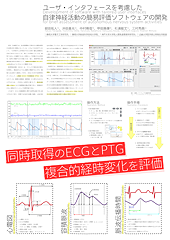To improve the precision of the material identification by Dual X-ray CT with polychromatic X-ray and energy discriminative detector, it is needed to acquire the energetic distribution of CT value accurately. Using sinograms and CT values from different energy by energy discriminative detection, a method to remove beam hardening error was examined.
 近年,先進国では,生活習慣病に代表される慢性疾患が主死亡原因となっており,疾病予防と健康促進を目的とした健康状況の簡易測定が必要とされている.著者らはこれまで,ストレスや食生活の変化を反映した心臓病等に関連する自律神経活動(ANA)に着目してきた.ANAの評価指標(脈波伝播時間(PTT)を含む)は,健康な被験者の心電図(ECG)と容積脈波(PTG)から得られる.本稿では,ECGとPTG の解析,評価指標と波形の可視化を行い,ユーザ・インタフェース(UI)を提供する,ANA簡易評価ソフトウェアを提案する.
近年,先進国では,生活習慣病に代表される慢性疾患が主死亡原因となっており,疾病予防と健康促進を目的とした健康状況の簡易測定が必要とされている.著者らはこれまで,ストレスや食生活の変化を反映した心臓病等に関連する自律神経活動(ANA)に着目してきた.ANAの評価指標(脈波伝播時間(PTT)を含む)は,健康な被験者の心電図(ECG)と容積脈波(PTG)から得られる.本稿では,ECGとPTG の解析,評価指標と波形の可視化を行い,ユーザ・インタフェース(UI)を提供する,ANA簡易評価ソフトウェアを提案する.
 Recently in developed countries, chronic conditions represented by lifestyle-related diseases have become leading causes of death. In these circumstances, primary or secondary prevention is the most effective way to avoid them. Hence, it is important to be able to monitor simply our health condition for both disease prevention and health promotion.
Recently in developed countries, chronic conditions represented by lifestyle-related diseases have become leading causes of death. In these circumstances, primary or secondary prevention is the most effective way to avoid them. Hence, it is important to be able to monitor simply our health condition for both disease prevention and health promotion.
We have focused on autonomic nervous activity (ANA) because it responds with stress as well as changes in dietary patterns, and it correlates with heart diseases. In this work, we consider both electrocardiogram (ECG) and plethysmogram (PTG) as the physiological data that reflects ANA. ECG and PTG obtained from healthy people provide several indices including aging index and pulse transmission time, and could be available as signs of asymptomatic illness. However, it is difficult to find predictive information from raw data of ECG and PTG.
In our work, we propose an application that analyzes ECG and PTG, and visualizes their indices and waveforms and call Mavep; it offers a tailored user interface (UI) enabling users to browse the two data checking their relationship, for brief assessment of ANA. We develop the application in Java from the viewpoint of portability, independence from specific platforms, putting weight on its UI for providing it as a tool for doctors. We implement both algorithms for analyzing raw data of ECG and PTG, and tailored UI that facilitates interaction between the physiological data and users.
近年の先進国での主死亡原因は生活習慣病を中心とした慢性疾患であり,疾病予防と健康促進のために健康状況の簡易モニター・システムが必要とされている.著者らは,ストレスや食生活の変化を反映した自律神経活動(ANA)に着目し,健康な被験者の心電図と容積脈波(PTG)から,ANAの評価指標を自動算出し,簡易評価を行うためのアプリケーションの開発を目指している.本稿では提案手法を用いて,PTGから経時的に変化する加齢指数(AGI)を求める.
非破壊検査技術であるX線CTは,医療や産業,セキュリティなどの様々な分野において利用されている.しかしながら,CT像(断面像)の取得には,通常,多ステップ(方向)からのX線照射が必要となるため,透過像撮像に比べて時間がかかり,全数検査等への応用は難しい.そこで著者らは,医療用の精度を必要としない分野を対象とし,高速な情報取得を可能とする超低ステップX線CTシステムの研究開発を行っている.
X線CT像は,複数の角度から照射されたX線が対象物を透過した際の減弱係数に基づいて再構成される.理想的にはあらゆる角度からX線を照射することが望ましいが,様々な制約(本稿では特に時間的制約)から困難であり,それ故,再構成されたCT像には,アーチファクトと呼ばれる像の乱れや歪みが発生してしまう.超低ステップX線CTシステムの実現には,再構成時におけるアーチファクトの低減が鍵となる.
- 要旨(PDF) © 社団法人応用物理学会
本稿では,色のカテゴリカル知覚と色覚特性の違いを考慮した,配色調整問題の定式化手法と,その実装を提案する.提案手法は,公共スペースのフロア・マップや書籍や論文などの図といった,情報の表現に焦点を当てている.これらの情報表現には,アート・デザインと媒体の二つの側面があるため,配色の調整には困難が伴い,最適な配色の組み合わせは容易には決定されない.著者らは,この問題に対する取り組みとして,人工知能の一分野であるファジィ制約充足問題として定式化する手法を既に提案している.本稿では,色のカテゴリカル知覚(色名と色覚の関係)に着目し,提案手法を改良する.また,この手法のグレースケール変換への応用例を示す.
© 2011 IEICE
We propose a formulation of the problem of color scheme adjustment and a prototype system that automatically solves it, taking into account color vision deficiencies. Our work focuses on the representation of information, such as floor maps of public spaces and figures in books and papers. Color schemes of these representations carry two aspects: the aspect of art design and the aspect of media. The aspect of art design allows the creation of appealing color schemes using the sensitivity to beauty or theme of the contents. The aspect of media, on the other hand, provides information easy to understand. In particular, in the second aspect, designers need to consider universal design. However, these two aspects make any color scheme adjustments difficult, and the optimal combination of colors is not easily determined. The original color scheme made by a designer should not change drastically from the viewpoint of art, and at same time, the scheme must be understandable to everyone even to those with color vision deficiencies. To solve this difficulty posed to designers, we formulate our color scheme adjustment as a fuzzy constraint satisfaction problem, a framework studied in the field of artificial intelligence. In our formulation, we employ the index of color conspicuity, which defines how easily-noticeable a color is for retaining the impression of the original color scheme. To prove the feasibility of the concept, we develop a prototype system in Java that automatically adjusts colors given by a designer.